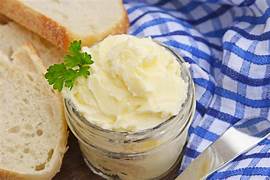Butter

Butter, a yellow-to-white solid emulsion of fat globules, water, and inorganic salts produced by churning the cream from cows’ milk. Butter has long been used as a spread and as a cooking fat. It is an important edible fat in northern Europe, North America, and other places where cattle are the primary dairy animals. Butter has a flavor all its own. Generally, butter is soft, creamy, and rich, with just a hint of sweetness, which is why the word “buttery” is often used to describe other foods. Butter is a popular dairy product made from cow’s milk. Composed of milk fat that has been separated from other milk components, it has a rich flavor and is widely used as a spread, as well as for cooking and baking. Airy: A light, pillowy texture often created by the incorporation of air. Buttery: A smooth and creamy texture similar to that of butter. Chewy: The texture of a food that needs to be chewed thoroughly before swallowing. Butter is a dairy product made from separating whole milk or cream into fat and buttermilk. The fat is compressed and chilled into blocks of butter. It can be used directly as a condiment or melted for frying or coating. Butter is also used in baking, such as in classic sponges and pastries, or for enriching sauces. Butter contains vitamin D, a nutrient that is vital for bone growth and development. It also has calcium, which is essential for bone strength. Calcium also helps prevent diseases such as osteoporosis, a condition that makes bones weak and fragile. It can help make your skin healthier. Butter is a water-in-oil emulsion resulting from an inversion of the cream, where the milk proteins are the emulsifiers. Butter remains a firm solid when refrigerated, but softens to a spreadable consistency at room temperature, and melts to a thin liquid consistency at 32 to 35 °C (90 to 95 °F).